Portrait of Aaron IV
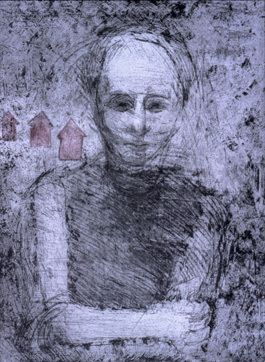
Portrait of Aaron IV
etching & engraving
76 x 56cm.

Portrait of Aaron IV
etching & engraving
76 x 56cm.
May 19, 2005 in Older Works, Printworks Comments Off on Portrait of Aaron IV
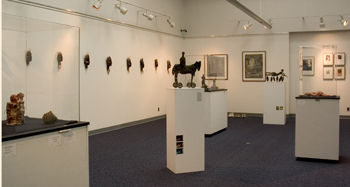
I am so glad I made it out yesterday to see Olga Campbell’s exhibition Whispers Across Time before it’s closure tonight.
It is very moving and powerful in theme, a kind of catharsis perhaps for the artist as she explores the loss of family. The work is also very intimate as one looks at images of small photos and details, partly obscured, a suggestion of looking through weathered and worn photo albums and diaries. Most of the sculptural work is small in scale, the many life size or smaller masks of the same face (hers?), the hands, the feet and the small scale figures. The interesting use of textures in all the work enhances the feeling of time and weathering. This is a large body of work in a variety of media within sculpture, paintings and prints (mostly lift and monoprints), evidence of a long journey of exploration and discovery through the act of creation.
The person looking after the gallery told me that the opening, which I was very sorry to miss, was very well attended and the work received with great appreciation. She also pointed out that the guest book was full of comments except for about two pages, something they had never seen in any of their shows in this gallery! Congratulations, Olga, on your success in touching many people with your work!
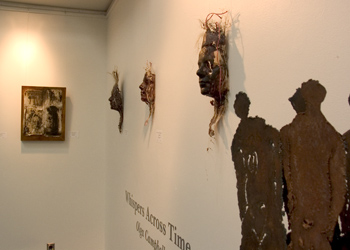
May 18, 2005 in Art Exhibitions, Other artists Comments Off on Olga Campbell’s Whispers
As readers know, I’m fascinated by rock art, so Tom Montag – The Middlewesterner’s recent posts about a rock art conference that he is involved with really grabbed my attention. As media coordinator for the 2005 ESRARA Rock Art Conference in Wisconsin, Tom interviewed two participants.
The first one with Jack Steinbring particularly interested me when I read that in the early part of his career he was founder and chair of the anthropology department at the University of Winnipeg. (As some readers know, my childhood and early adult years were spent in Winnipeg, and many happy holidays in the Whiteshell.)
Jack Steinbring describes in fascinating detail the finding and mapping (1966-1970), with a student of his, of the largest petroform site in North America at Tie Creek in Whiteshell Provincial Park. It covers nine acres. It has seven interconnected features, one of them over a hundred feet long. One has a bird shape, one is a huge rectangle, there’s a circle with a triangle in the middle, and a great elliptical shape. These were obviously placed there by man, not by natural agency. The term “petroform” was invented by that student who later became Dr. Peter Douglas Elias. These big features and images imagined from a perspective of altitude were already known in the American southwest and called “geo-glyphs”. After many requests for protection of the site, it was fenced in and locked in 1978. I have never heard about this site or about petroforms until reading this, so it’s exciting to me.
He also says, the image present in the mind of the public is greatly conditioned by the cave art in Europe, which is spectacular, and more attention was directed toward it at the beginning of interest in ancient art. Now we call this “Euro-centric,” meaning that judgments about rock art are conditioned by the rock art of Europe, when in fact rock art covers the globe. There are many areas around the world that have immensely greater concentrations of rock art than Europe – for instance, Australia, South Africa, and the southwestern United States. There’s much more fascinating information, including about the Peachy petroform site near Rosendale, Wisconsin, which will be part of a field trip for the conference participants.
The second interview with Robert (Ernie) Boszhardt is also interesting, dealing mainly with Wisconsin’s petroforms. He adds, The problem is that there are not many rock art sites openly accessible to the public. That is because of the fear of vandalism to the sites, such as the spray-painting at Roche-a-Cri. Or at the Goschell site, where a person tried to saw a piece of rock art out of the rock face and destroyed a pristine site in the process. The dilemma is this: you want to let people see the rock art, so they become excited about it, and at the same time you want to protect the rock art. It takes only one vandal to destroy a site.
In fact it’s also hard to find any images and information on the petroforms online, including Tie Creek petroform site in Manitoba. Manitoba Conservation’s Parks page has a bit about Bannock Point Petroforms: The Bannock Point Petroforms are figures laid out on bedrock in the forms of turtles, snakes and humans, and also in abstract patterns. Anishinabe and other First Nations people believe that they were left here long ago for the benefit of all people that might visit this site to receive their teachings and healing. There are no fixed interpretations of the figures. There are many levels of understanding, therefore, many ways to interpret the teachings.
The Petroforms of Manitoba provides more information with a few illustrations, such as “Teaching Places, Healing Places” on how the sites are still used as sacred places by the Anishinabe. Here’s a definition of petroforms : Petroforms are defined as features formed by the placement (not piling) of stones to create the outlines of figures or shapes. The stones or small boulders are arranged on bedrock outcrops in the shapes of snakes, turtles, humans and geometric forms. Archaeologists group petroforms with rock paintings or “pictographs” and refer to them as “rock art,” although both are thought to have been made by Native people for religious purposes. It seems likely that petroforms were intentionally built in remote places so that whatever ceremonies were conducted there could be done privately.
Some illustrations here remind me of the Seidas of Northern Europe, the ones on fields or forest glens with the rocks laid out in formations, not the stacked rocks. Once again there is evidence of a world-wide similarity in the rock art works of earliest man.
One of the few interpretations given is of this illustration I lifted of a human effigy feature as an example of the theme of Immortality: This feature has to do with a teaching or legend that has a meaning for all people. In the legend, one of the Anishinabe people asked Waynaboozhoo (who is both good and evil, both human and spirit) for everlasting life. This person wanted immortality, so Waynaboozhoo turned him into a rock. We must be careful what we wish for.
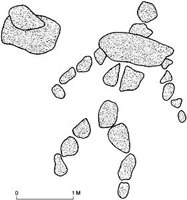
ADDENDUM:
Found some links for Wisconsin rock art sites with photos:
Mississippi Valley Archaeology Center and the recently discovered Deep Cave
Umrara has several links
May 17, 2005 in Rock Art & Archaeology 4 Comments »
How intriguing! A couple of days ago, in a playful mood, I posted a quiz that identified me as a Cultural Creative. Last night as I browsed through some blogs that I visit on a biweekly basis, I came across a post called “ARE YOU A CULTURAL CREATIVE?” at Robert Brady’s Pure Land Mountain.
Here I learn that there is an actual Cultural Creative organization. These movements include those focused on civil rights, the environment, womens rights, peace, jobs and social justice, gay and lesbian rights, alternative health care, spirituality, personal growth, and now, of course, stopping corporate globalization. All of those concerns are now converging into a strong concern for the whole planet.
Curiously, the words cultural and creative are given new meaning here. It’s interesting reading, offering a very positive world view, yet it’s strange that the authors mainly focus on Americans, while I believe these “cultural creatives” as labelled are everywhere. Do go read Brady’s post and the links and please let me know what you think!
May 16, 2005 in Being an Artist 1 Comment »
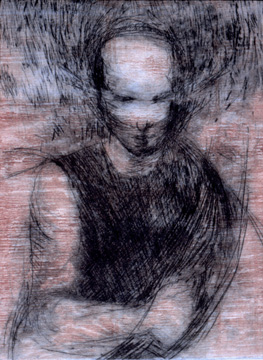
Portrait of Aaron III
drypoint & woodcut
76 x 56cm.
May 15, 2005 in Older Works, Printworks Comments Off on Portrait of Aaron III
It’s been a busy week with family. Our oldest daughter, who has been living in the Interior since last fall, has been here this week on business. It was great having her here for our youngest daughter’s 20th birthday which we celebrated with all our family at a Thai restaurant. Today eldest took off for a conference in Winnipeg. I have just changed the linens for a sister-in-law who’s coming for this weekend. Tuesday night eldest returns for one night on her way home, so it feels like I’m running a bed-and-breakfast! Ah well, not to complain, I do enjoy seeing the family, but isn’t it funny how “when it rains, it pours?”
Since I had a few minutes to spare to wander the blogosphere, and maybe feeling a bit silly from cleaning fumes, I did this quiz , something I usually ignore because the results are usually meaningless. I rather like the results on this one, so decided to share the fun – try it!
 |
You scored as Cultural Creative. Cultural Creatives are probably the newest group to enter this realm. You are a modern thinker who tends to shy away from organized religion but still feels as if there is something greater than ourselves. You are very spiritual, even if you are not religious. Life has a meaning outside of the rational.
What is Your World View? |
Found at Fresh Paint
May 14, 2005 in Being an Artist, Home, Neat stuff Comments Off on a quiz
I just came across this little item in the online version of Vancouver’s arts newspaper The Georgia Straight. I’ve lifted it in its entirety below. I had heard about the controversial show but not seen it. I must say I admire Crist’s comment, a voice in the wilderness of the North Shore, it seems. What do you think of this?
Everybody Loves Landscapes
By pieta woolley
Publish Date: 12-May-2005
The District of North Vancouver Municipal Hall art gallery, which removed a controversial exhibit in March, is opening another show on Thursday (May 12). This time, there likely won’t be any controversy. Art in Public Places will present Joan Baron’s “large, bright and bold landscapes”, and Sharon Greig’s “intricate pine needle baskets and weaving”, according to the press release.
In response to the removal of Shawn Stibbards’s paintings of guns and semi-naked women, North Vancouver District Coun. Ernie Crist complained that the gallery doesn’t have any guts. “Art is controversial always,” he told the Straight, “because artists always have something to say. Should we just hang paintings of blueberry bushes and turnips in district hall?”
Art in Public Places is open at the hall weekdays from 8:30 a.m. until 4:30 p.m.
May 12, 2005 in Art Exhibitions 2 Comments »
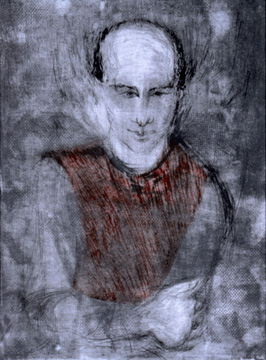
Portrait of Aaron II
drypoint & etching
76 x 56cm.
May 12, 2005 in Older Works, Printworks Comments Off on Portrait of Aaron II
Melanie McBride of chandrasutra* felt that Big Media has been misrepresenting bloggers and decided that it was time we spoke for ourselves and let them (and everybody else know) who we actually are, who we link to and why we blog. She decided to do an interview series by bloggers about bloggers to publish onchandrasutra*. She sent out questions to a selection of bloggers she read, from well known to lesser known bloggers, men and women from different walks of life.
Now I’m excited that Melanie has posted her interview of me*. I feel very thrilled and honoured to be included with such a distinguished group of bloggers! Many thanks, Mel!
UPDATE May 14, 2007: *Chandrasutra has gone offline. Please see this post.
May 11, 2005 in Being an Artist, Blogging 8 Comments »
“Welcome to the coudal.com Museum of Online Museums. Here, you will find links from our archives to online collections and exhibits covering a vast array of interests and obsessions: Start with a review of classic art and architecture, and graduate to the study of mundane (and sometimes bizarre) objects elevated to art by their numbers, juxtaposition, or passion of the collector.”
There’s a great deal from weird to wonderful to explore here. I notice that Virtual Museum of Canada is listed as a sole Canadian site. I’ve seen it before and though it has its merits, the site is quite “blah”, not a good example of exciting web design.
(found at january blog)
May 10, 2005 in Art Exhibitions, Culture Comments Off on MoOm
© Marja-Leena Rathje 2004-2024